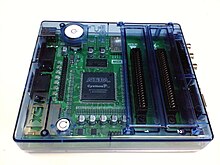
A field-programmable gate array (FPGA) is an integrated circuit designed to be configured by a customer or a designer after manufacturing – hence the term field-programmable. The FPGA configuration is generally specified using a hardware description language (HDL), similar to that used for an application-specific integrated circuit (ASIC). Circuit diagrams were previously used to specify the configuration, but this is increasingly rare due to the advent of electronic design automation tools.

A programmable logic device (PLD) is an electronic component used to build reconfigurable digital circuits. Unlike digital logic constructed using discrete logic gates with fixed functions, a PLD has an undefined function at the time of manufacture. Before the PLD can be used in a circuit it must be programmed to implement the desired function. Compared to fixed logic devices, programmable logic devices simplify the design of complex logic and may offer superior performance. Unlike for microprocessors, programming a PLD changes the connections made between the gates in the device.

AVR is a family of microcontrollers developed since 1996 by Atmel, acquired by Microchip Technology in 2016. These are modified Harvard architecture 8-bit RISC single-chip microcontrollers. AVR was one of the first microcontroller families to use on-chip flash memory for program storage, as opposed to one-time programmable ROM, EPROM, or EEPROM used by other microcontrollers at the time.

MSX is a standardized home computer architecture, announced by Microsoft and ASCII Corporation on June 16, 1983. It was initially conceived by Microsoft as a product for the Eastern sector, and jointly marketed by Kazuhiko Nishi, then vice-president at Microsoft and director at ASCII Corporation. Microsoft and Nishi conceived the project as an attempt to create unified standards among various home computing system manufacturers of the period, in the same fashion as the VHS standard for home video tape machines.

A memory card is an electronic data storage device used for storing digital information, typically using flash memory. These are commonly used in digital portable electronic devices. They allow adding memory to such devices using a card in a socket instead of a protruding USB flash drives.
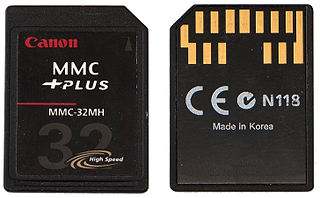
The MultiMediaCard, officially abbreviated as MMC, is a memory card standard used for solid-state storage. Unveiled in 1997 by SanDisk and Siemens, MMC is based on a surface-contact low pin-count serial interface using a single memory stack substrate assembly, and is therefore much smaller than earlier systems based on high pin-count parallel interfaces using traditional surface-mount assembly such as CompactFlash. Both products were initially introduced using SanDisk NOR-based flash technology. MMC is about the size of a postage stamp: 32mm × 24 mm × 1.4mm. MMC originally used a 1-bit serial interface, but newer versions of the specification allow transfers of 4 or 8 bits at a time. MMC can be used in many devices that can use Secure Digital (SD) cards.
JTAG is an industry standard for verifying designs and testing printed circuit boards after manufacture.

The Catweasel is a family of enhanced floppy-disk controllers from German company Individual Computers. These controllers are designed to allow more recent computers, such as PCs, to access a wide variety of older or non-native disk formats using standard floppy drives.

The MPU-401, where MPU stands for MIDI Processing Unit, is an important but now obsolete interface for connecting MIDI-equipped electronic music hardware to personal computers. It was designed by Roland Corporation, which also co-authored the MIDI standard.
In computer engineering and electrical engineering, bit banging is a "term of art" for any method of data transmission that employs software as a substitute for dedicated hardware to generate transmitted signals or process received signals. Software directly sets and samples the states of GPIOs, and is responsible for meeting all timing requirements and protocol sequencing of the signals. In contrast to bit banging, dedicated hardware satisfies these requirements and, if necessary, provides a data buffer to relax software timing requirements. Bit banging can be implemented at very low cost, and is commonly used in some embedded systems.

The AY-3-8910 is a 3-voice programmable sound generator (PSG) designed by General Instrument in 1978, initially for use with their 16-bit CP1610 or one of the PIC1650 series of 8-bit microcomputers. The AY-3-8910 and its variants were used in many arcade games—Konami's Gyruss contains five—and pinball machines as well as being the sound chip in the Intellivision and Vectrex video game consoles, and the Amstrad CPC, Oric-1, Colour Genie, Elektor TV Games Computer, MSX, and later ZX Spectrum home computers. It was also used in the Mockingboard and Cricket sound cards for the Apple II and the Speech/Sound Cartridge for the TRS-80 Color Computer.

This article is about the various external peripherals of the Commodore 64 home computer. Due to the backwards compatibility of the Commodore 128, most peripherals will work on that system, as well. There's some compatibility with the VIC-20 and PET too.
Altera Hardware Description Language (AHDL) is a proprietary hardware description language (HDL) developed by Altera Corporation. AHDL is used for digital logic design entry for Altera's complex programmable logic devices (CPLDs) and field-programmable gate arrays (FPGAs). It is supported by Altera's MAX-PLUS and Quartus series of design software. AHDL has an Ada-like syntax and its feature set is comparable to the synthesizable portions of the Verilog and VHDL hardware description languages. In contrast to HDLs such as Verilog and VHDL, AHDL is a design-entry language only; all of its language constructs are synthesizable. By default, Altera software expects AHDL source files to have a .tdf extension.
The boot ROM is a type of ROM that is used for booting a computer system.

Minimig is an open source re-implementation of an Amiga 500 using a field-programmable gate array (FPGA).
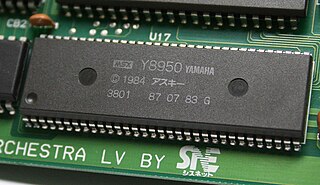
The Yamaha Y8950 is a sound chip, produced in 1984. Essentially a Yamaha YM3526 with an ADPCM encoder/decoder added on, it is also known as MSX-Audio as it was designed for inclusion in an expansion cartridge for the MSX personal computer.

The BeagleBoard is a low-power open-source single-board computer produced by Texas Instruments in association with Digi-Key and Newark element14. The BeagleBoard was also designed with open source software development in mind, and as a way of demonstrating the Texas Instrument's OMAP3530 system-on-a-chip. The board was developed by a small team of engineers as an educational board that could be used in colleges around the world to teach open source hardware and software capabilities. It is also sold to the public under the Creative Commons share-alike license. The board was designed using Cadence OrCAD for schematics and Cadence Allegro for PCB manufacturing; no simulation software was used.

A game backup device, informally called a copier, is a device for backing up ROM data from a video game cartridge to a computer file called a ROM image and playing them back on the official hardware. Recently flash cartridges, especially on the Game Boy Advance and Nintendo DS platforms, only support the latter function; they cannot be used for backing up ROM data. Game backup devices also make it possible to develop homebrew software on video game systems. Game backup devices differ from modchips in that modchips are used in conjunction with systems that use generally available media such as CDs and DVDs, whereas game backup devices are used with systems that use cartridges.
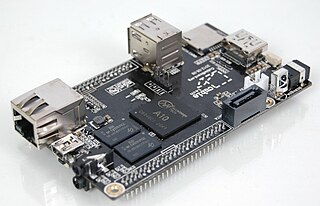
Cubieboard is a single-board computer, made in Zhuhai, Guangdong, China. The first short run of prototype boards were sold internationally in September 2012, and the production version started to be sold in October 2012. It can run Android 4 ICS, Ubuntu 12.04 desktop, Fedora 19 ARM Remix desktop, Armbian, Arch Linux ARM, a Debian-based Cubian distribution, FreeBSD, or OpenBSD.
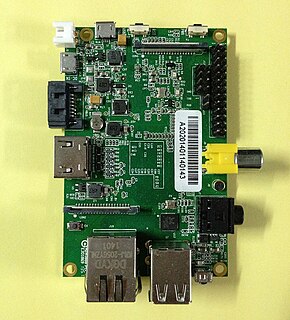
Banana Pi is a line of single-board computers produced by the Chinese company Shenzhen SINOVOIP Co., Ltd. and its spin-off Guangdong BiPai Technology Co., Ltd.. The hardware design of the Banana Pi computer model was influenced by the Raspberry Pi and both lines use the same 40 pin I/O connector.
